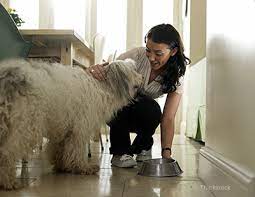
Dog Surgery A-Z
AJ Debiasse, a technician in Stroudsburg, PA, contributed to this article
Your dog’s thyroid glands produce a hormone that regulates metabolism and multiple body functions. Dogs can develop a tumor in one or rarely both thyroid glands, which are located on either side of the beginning of the trachea or windpipe. The tumor is either benign or cancerous. However, most thyroid tumors are malignant (or cancerous) in dogs, and they have a tendency to spread to other organs.
Symptoms of thyroid tumors
The symptoms of thyroid tumors vary greatly. Some tumors become large enough that they are palpable or visible on the neck. If the tumor is large enough, it can push on the trachea or the esophagus (the tube from the mouth to the stomach). If this happens, then you may notice:
- Difficulty breathing
- Coughing
- Changes in bark sounds
- Difficulty swallowing or gagging
In rare cases, cancerous tumors can cause the thyroid glands to produce the hormone in excess, causing hyperthyroidism. Things you would notice at home, in this case, include:
- An increase in appetite
- Weight loss
- Skin and coat problems
- Increases in drinking and urination
Thyroid tumors are most common in middle-age, large-breed dogs but can occur in all pets. The cause is unknown.
Since thyroid tumors share symptoms with other diseases like airway diseases, metabolic diseases such as diabetes, kidney insufficiency and allergies, it is important to have a full physical exam, full blood work and imaging. If the tumor is large enough, it may be visible on X-rays but a CAT scan is most helpful and can also help determine how invasive it may be.
Treating a thyroid tumor with surgery
Thyroid tumors can be surgically removed. This can be tricky because of the location of the mass and the fact that it can be extremely rich in blood vessels, which cause massive bleeding. Due to the risk of bleeding, it is important to perform a clotting test before surgery. In fact, some tumors have so many blood vessels, that it is impossible to remove the tumor safely. If your pet is not a surgical candidate, the tumor is inoperable or the tumor was removed but not in its entirety, radiation, radioactive iodine or chemotherapy may be performed.
After surgery, the mass is sent to the lab for analysis. This will determine what the mass is and whether or not it was entirely removed.
Surgical recovery time is usually 14 to 21 days. Your pet will require a harness rather than a neck collar until completely healed. Activity should be restricted. The incision should be checked 14 days after surgery to confirm proper healing.
After thyroid tumor surgery
Oral antibiotics and pain medications are given after surgery. After thyroid gland removal, low calcium (hypocalcamia) or low thyroid hormone levels (hypothyroidism) may occur. Both require blood work and may lead to giving calcium or thyroid hormone supplements. Besides the risk of any anesthetic procedure [see common anesthesia myths here], other risks of thyroid gland removal include bleeding and laryngeal paralysis.
Surgery patients live an average of 1 to 3 years after removal of a cancerous thyroid tumor. This depends on the size of the mass, spreading of the tumor and radiation and/or chemotherapy follow up.







